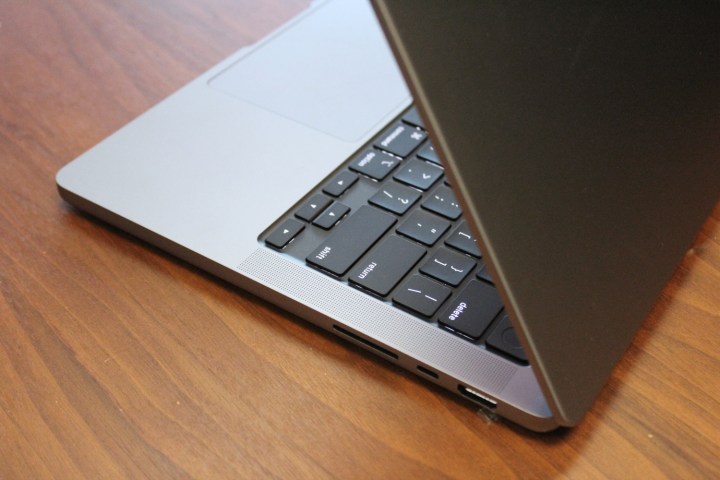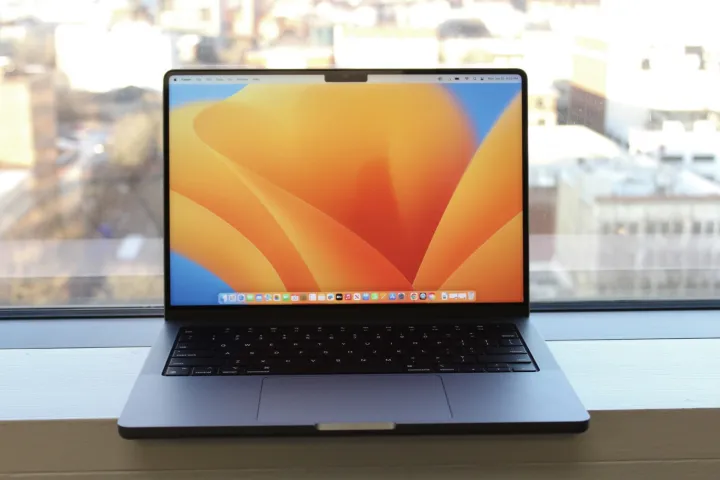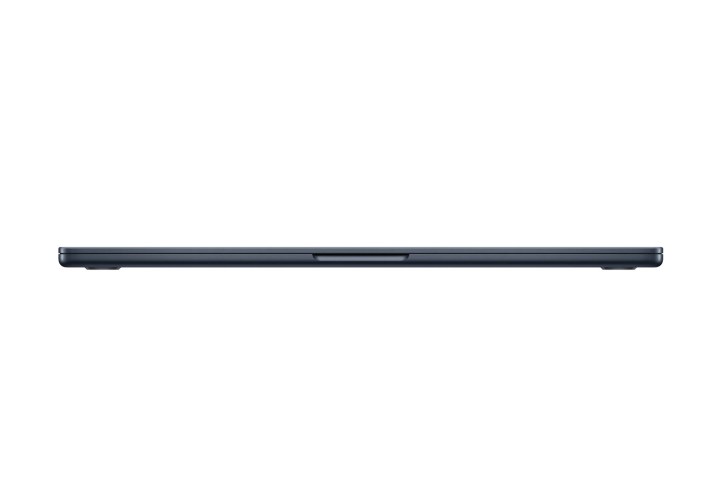Apple introduced a brand-new member to its MacBook lineup, a larger MacBook Air model with a 15.3-inch display that utilizes the same base M2 processor as the latest MacBook Air 13. The idea, clearly is to provide a larger laptop that retains the incredible thinness and lightness of the MacBook Air, but with more screen real estate to work with.
In this comparison, it’s going up against the MacBook Pro 14, with a display that’s about an inch smaller diagonally at 14.2 inches. The thing is, the MacBook Pro 14 is in a different class entirely when it comes to performance, with M2 Pro and M2 Max CPUs, as well as a truly stunning Mini-LED panel. Which one is right for you?
Specs
| Apple MacBook Air 15 | Apple MacBook Pro 14 | |
| Dimensions | 13.40 inches x 9.35 inches by 0.45 inches | 12.31 inches by 8.71 inches by 0.60 inches |
| Weight | 3.3 pounds | 3.5 pounds |
| Processor | Apple M2 | Apple M2 Pro Apple M2 Max |
| Graphics | Integrated | Integrated |
| RAM | 8GB 16GB 24GB |
16GB 32GB 64GB 96GB |
| Display | 15.3-inch 16:10 Liquid Retina IPS 2,880 x 1,864 | 14.2-inch 16:10 Liquid Retina XDR 3024 x 1964 |
| Storage | 256GB SSD 512GB SSD 1TB SSD 2TB SSD |
512GB SSD 1TB SSD 2TB SSD 4TB SSD 8TB SSD |
| Touch | No | No |
| Ports | 2 x USB-C with Thunderbolt 4 1 x 3.5mm audio jack |
3 x USB-C with Thunderbolt 4 1 x HDMI 2.0 1 x 3.5mm audio jack SD card reader |
| Wireless | Wi-Fi 6 and Bluetooth 5.3 | Wi-Fi 6E and Bluetooth 5.0 |
| Webcam | 1080p | 1080p |
| Operating system | MacOS Monterey | MacOS Monterey |
| Battery | 66.5 watt-hour | 70 watt-hour |
| Price | $1,300+ | $2,000+ |
| Rating | Not yet reviewed | 5 out of 5 stars (M1 version) |
The MacBook Air 15 starts at $1,300 with an 8-core CPU/10-core GPU M2 processor, 8GB of RAM, a 256GB SSD, and a 15.3-inch Liquid Retina IPS display. It tops out at $2,500 with 24GB of RAM and a 2TB SSD.
The MacBook Pro 14 is a much more expensive laptop, with a starting price of $2,000 for a 10-core CPU/16-core GPU M2 Pro, 16GB of RAM, a 512GB SSD, and a 14.2-inch Liquid Retina Mini-LED display. Max it out, and you’ll spend a whopping $6,300 for a 12-core CPU/38-core GPU M2 Max, 96GB of RAM, and 8TB of storage.
If you don’t need the sheer power of the MacBook Pro 14 and can live without the inky blacks and extreme brightness, then the MacBook Air 15 will save you tons of money.
Design

As mentioned in the intro, the MacBook Air 15 adopted the same design as the MacBook Air M2. That is, it looks a lot like the MacBook Pro 14, only slightly larger in width and depth, but a lot thinner at 0.45 inches versus 0.60 inches. It’s also lighter at 3.3 pounds versus 3.5 pounds. Imagine a MacBook Pro 14 that was placed on a cutting board and spread out a little with a rolling pin and you’ll get the idea. Of course, that’s a good thing, because the slightly boxy look that’s now common to all the MacBook models is elegant in its simplicity and, while it doesn’t stand out, it doesn’t need to. The MacBook Air 15 is more colorful than its sibling, though, as it’s available in Starlight and Midnight colors to go with Silver and Space Gray.
We haven’t gone hands-on with the MacBook Air 15 yet, but we imagine that it will have the same superior build quality that all MacBooks enjoy. One thing we noted with the MacBook Air 14 M2 is that in being so incredibly thin, there is some uncharacteristic bending to the lid that you won’t find on the MacBook Pro 14, which is incredibly solid all around. It wouldn’t be surprising if there’s the same kind of bending in the lid on the larger model given that it’s almost nearly as thin.
The MacBook Air 15 has less connectivity than the MacBook Pro 14, with just two Thunderbolt 4 ports and an audio jack (like the MacBook Air 13-inch). The Pro models come with three Thunderbolt 4 ports to go with an HDMI port and a full-size SD card reader. That makes the MacBook Pro 14 a lot more expandable. Both utilize MagSafe 3 chargers, though, saving a Thunderbolt 4 port for external use. The Apple website lists Wi-Fi 6 for the MacBook Air 15 rather than the newer Wi-Fi 6E that’s listed for the MacBook Pro 14, and both have Bluetooth 5.3 support.
Because the MacBook Air M1 uses the base M2 CPU, it’s limited to just one external display with up to 6K resolution at 60Hz. The MacBook Pro 14 with the M2 Pro can handle two external displays, one at 6K/60Hz over Thunderbolt 4 ports and one 6K/60Hz combined with a 4K resolution at 144Hz if the HDMI port is used for the second display. The M2 Max model can handle up to four external displays, three at 6K/60Hz via Thunderbolt 4 and one at 4K/144Hz over HDMI. If you limit it to three displays, the HDMI port can drive a monitor at up to 4K/240Hz. The MacBook Pro 14 is the laptop for you if you need more than just a single external display.
The MacBook Air uses the same Magic Keyboard as the rest of the MacBook lineup, and so we expect its typing experience to be just as sublime as with the MacBook Pro 14. And its Force Touch touchpad should be equally as good and slightly larger.
Finally, both laptops offer 1080p webcams, with Apple’s excellent software providing an outstanding image for videoconferencing. Both are also secured by Touch ID embedded in the power button.
Performance

The MacBook Air M2 uses Apple’s base M2 CPU, specifically the model with eight CPU cores and 10 GPU cores, with a 16-core Neural Engine. As such, it should provide similar performance to the MacBook Air 13-inch that we reviewed. The MacBook Pro 14 can be equipped with either the M2 Pro or M2 Max with a variety of CPU and GPU core counts. Simply put, the MacBook Pro 14 is a much faster laptop.
To come up with some kind of comparison, we’ll use the MacBook Pro 13 M2 results as a proxy for now. It’s possible that the MacBook Air 15 will be slightly faster thanks to potentially better thermals, but we’ll have to wait until we review it to be sure.
These results aren’t fair at all given that we reviewed the MacBook Pro 14 with the superfast M2 Max CPU, but it does show the delta in potential performance between the two laptops. The MacBook Air 15 might be slightly larger, but it’s likely to be close to only half as fast as the MacBook Pro 14.
| Geekbench (single / multi) |
Handbrake (seconds) |
Cinebench R23 (single / multi) |
Pugetbench Premiere Pro |
|
| MacBook Air 13 M2 (M2 8/10) |
1,925 / 8,973 | 151 | 1,600 / 7,938 | 497 |
| MacBook Pro 14 M2 (M2 Max 10/38) |
1,973 / 14,596 | 85 | 1,608 / 14,789 | 1,093 |
Display

Another MacBook Pro 14 advantage is its 14.0-inch Mini-LED Liquid Retina display running at 3,024 x 1,924 (254 PPI) resolution, which provides superior sharpness, brightness, color, and contrast compared to the standard IPS Liquid Retina display on the MacBook Air line. This includes the MacBook Air 15, which has a 15.3-inch IPS Liquid Retina display at 2,880 x 1,864 (228 PPI).
Again, we’ll use the MacBook Air 13 M2 display as a proxy, and we’ll update once we’ve had a chance to test the MacBook Pro 15’s panel. We expect that the results will be similar, however.
Both displays should offer similar colors, in terms of both gamut and accuracy. But the Mini-LED panel on the MacBook Pro 14 will get much brighter, especially for high dynamic range (HDR) content where it can approach 1,000 nits or more. It also has incredibly deep contrast providing inky blacks. The MacBook Air 15’s display is likely to be excellent, but the MacBook Pro 14 provides a truly stunning experience. The MacBook Pro 14 display also supports Apple’s ProMotion technology for up to a 120Hz refresh rate depending on the content. That will make a smoother viewing experience than with the MacBook Air 15.
| MacBook Air 13 (IPS) |
MacBook Pro 14 (Mini-LED) |
|
| Brightness (nits) |
486 | 511 |
| AdobeRGB gamut | 100% | 100 |
| sRGB gamut | 90% | 89% |
| Accuracy (DeltaE, lower is better) |
1.08 | 1.13 |
| Contrast ratio | 1,310:1 | 35,450:1 |
Both laptops have six-speaker sound systems with force-canceling woofers. They support the same technologies as well, meaning that you’re likely to get the same excellent sound from both that’s among the best you can get in a modern laptop.
Portability

The MacBook Air 15 is both thinner and lighter than the MacBook Pro 14. In fact, it’s the thinnest 15-inch laptop you can buy today. It will still take up a little more space in your backpack due to the larger display, but it’s not going to weigh you down.
The MacBook Pro 14 has a larger battery than the MacBook Air 15, a more power-hungry display, and much more powerful CPUs. Apple promises up to 18 hours of movie playback and up to 12 hours of wireless web use with the MacBook Pro 14. For the MacBook Air 15, Apple estimates up to 18 hours of movie playback and up to 15 hours or wireless web. We’ll have to wait until we can run our own tests, but it’s likely that both laptops will provide long battery life.
Leave the MacBook Air 14 for the pros
The MacBook Pro 14 is going to be a lot faster than the MacBook Air 15, and it’s going to have a better display. These things we can be sure of. But it’s also much more expensive, equipped and priced for professionals who will use it for demanding tasks like high-end photo editing and extreme video processing.
The MacBook Air 15 is a fascinating laptop for the rest of us. It should provide excellent productivity performance with a larger display that provides more room for multitasking. It’s just as thin as the MacBook Air 13, while being just about a pound heavier. It’s a better choice for most Mac users.
Editors’ Recommendations
